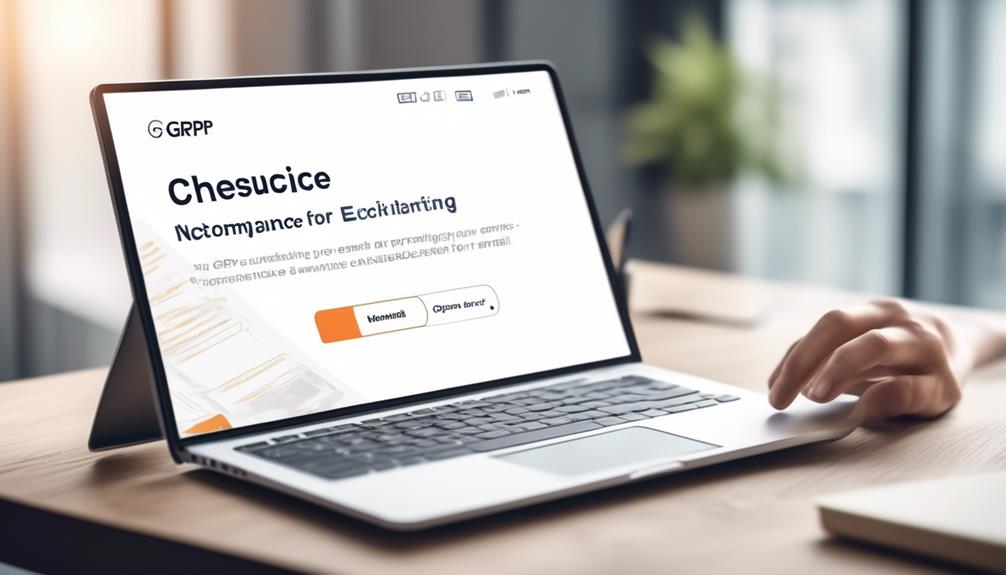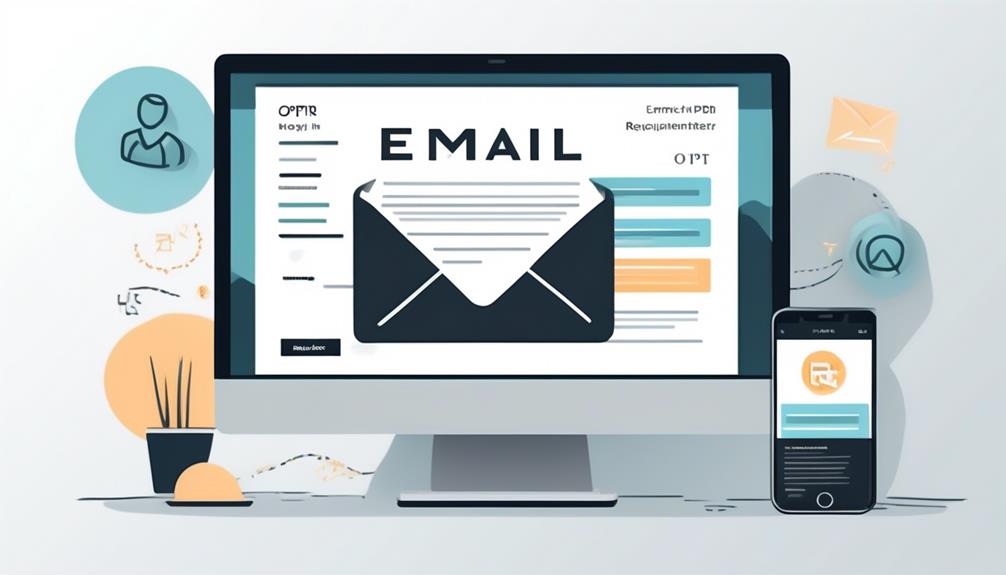Navigating the complexities of GDPR and its effect on email marketing strategies is like navigating through a maze; it requires careful attention to detail and a deep understanding of the rules and regulations.
As businesses, we must adapt our email marketing strategies to align with GDPR requirements to ensure that our practices are compliant and respectful of customer privacy.
With the stakes higher than ever, it's essential to comprehend the nuances of consent, data protection, and email communication.
Join us as we explore the impact of GDPR on email marketing, unravel the intricacies of consent requirements, and uncover best practices to build and maintain customer trust in this new landscape.
Key Takeaways
- Obtaining explicit consent is crucial for email marketing under GDPR.
- Businesses need to review and adjust their email marketing practices to align with stricter consent requirements.
- GDPR compliance can lead to improved revenues and stronger customer relationships.
- The soft opt-in exception allows organizations to send marketing emails to existing customers without explicit consent, but strict guidelines must be followed.
Impact of GDPR on Email Marketing
In light of the GDPR's stringent regulations, it's imperative for businesses engaging in email marketing to obtain explicit consent from recipients to ensure compliance. Under the GDPR, personal data protection is paramount, and this extends to email marketing strategies.
Businesses must ensure that individuals have given clear consent to receive marketing emails, and this consent must be freely given, specific, informed, and unambiguous. Consent under the GDPR means that individuals must take a clear affirmative action to opt-in, and pre-ticked opt-in boxes or inactivity can't be considered as valid consent.
Therefore, businesses need to review and possibly adjust their current email marketing practices to align with these stricter consent requirements.
Moreover, GDPR compliance isn't just about avoiding fines; it's an opportunity to build trust with customers. By demonstrating transparency, respecting individuals' data, and providing clear opt-out options, businesses can enhance their reputation and foster stronger customer relationships.
Ultimately, GDPR compliance can lead to improved revenues as customers are more likely to engage with businesses that respect their privacy and communicate with them in a transparent and ethical manner.
Consent Requirements Under GDPR

Upon navigating the stringent regulations of GDPR in email marketing, businesses are required to adhere to specific consent requirements to ensure compliance and uphold individuals' data protection rights.
Under the GDPR, obtaining consent for email marketing must be freely given, specific, informed, and unambiguous. This means that individuals must actively opt in and be fully aware of how their personal data will be used for marketing purposes.
Moreover, businesses need to have a clear record of consent for processing personal data and must offer an easy opt-out option in all marketing communications. It's also crucial to note that for legacy contacts, consent for email marketing should be obtained or validated to ensure compliance.
Collecting personal data with explicit consent and reminding individuals of their right to opt out in every marketing communication are essential practices for meeting the GDPR's consent requirements.
Ultimately, businesses engaging in email marketing practices must prioritize obtaining and managing consent in a transparent and compliant manner to align with the GDPR's stringent regulations.
Email Marketing Best Practices Under GDPR
When ensuring compliance with GDPR in email marketing, businesses must prioritize explicit consent as a fundamental best practice for sending marketing emails. It's essential for businesses to understand and implement the following best practices under GDPR:
- Specific and Informed Consent: Obtain specific and informed consent from individuals, clearly outlining the purposes for which their personal data will be processed for marketing emails. Consent must be given through a clear affirmative action, such as ticking a box, and it should be separate from other terms and conditions.
- Data Minimization: Adhere to the principle of data minimization by collecting and processing only the necessary personal data for the intended marketing purposes. This ensures that businesses aren't holding excessive or irrelevant data.
- Secure Storage and Protection: Implement robust security measures to store and protect personal data against unauthorized or unlawful processing. This includes encryption, access controls, and regular security assessments to mitigate the risk of data breaches.
Adhering to these best practices not only ensures compliance with GDPR but also demonstrates respect for individuals' privacy rights and fosters trust between businesses and their customers.
Soft Opt-In Exception

The soft opt-in exception under GDPR allows organizations to send marketing emails to existing customers without explicit consent, provided that certain conditions are met.
This exception applies to previous customers who provided their contact details during a sale or negotiation for similar products or services.
It's crucial for organizations to offer an easy way for customers to opt out of receiving marketing messages and to ensure that the marketing relates to the same product or service.
Legal Consent Requirements
In email marketing practices, the soft opt-in exception under GDPR allows organizations to send marketing emails to existing customers with an opt-out option, provided that the contact details were obtained during a sale or negotiations for a sale of a product or service.
When considering legal consent requirements under GDPR for email marketing, it's vital to understand the specific conditions that apply to the soft opt-in exception:
- Context of Sale: Contact details must have been obtained in the context of a sale or negotiations for a sale of a product or service.
- Informed and Opt-Out: Individuals must have been kept informed and provided with an opt-out option from the start of communication.
- Similar Products or Services: The soft opt-in exception permits sending marketing emails for similar products or services, but individuals must be given the option to opt-out.
Understanding and adhering to these legal consent requirements is crucial for GDPR compliance in email marketing practices within the European Union.
Marketing to Existing Customers
After reviewing the legal consent requirements for email marketing under GDPR, it becomes imperative to understand the specific conditions that govern the soft opt-in exception and its application to marketing to existing customers.
The soft opt-in exception allows organizations to contact existing customers via email for similar products or services without explicit consent, provided that they've previously purchased a product or service. This exception doesn't extend to prospects or leads.
Marketers must ensure that a clear and simple opt-out option is provided in every marketing communication to comply with the soft opt-in exception.
It's crucial to uphold customer trust and respect personal data when processing information for marketing to existing customers under the GDPR regulations.
Opt-Out Options
To ensure compliance with the soft opt-in exception under GDPR, businesses must prioritize transparent and easily accessible opt-out options in all marketing communications. This ensures that recipients have control over their data and can withdraw consent at any time. To achieve this, businesses can:
- Provide a prominent and clearly labeled unsubscribe link in each marketing email.
- Offer alternative communication channels for opt-out requests, such as a dedicated email address or a preference management center on the company's website.
- Regularly update and honor opt-out requests to promptly cease further communication.
Purchased Marketing List Considerations

When considering the use of purchased marketing lists, organizations must exercise due diligence to ensure that individuals on the lists have provided clear consent in compliance with GDPR requirements. It's crucial for organizations to inform individuals about their identity and the source of their information if they're using purchased marketing lists. Additionally, providing an opt-out option is essential, and organizations should avoid relying on such lists if consent is uncertain.
Purchased marketing lists can be used, but organizations must ensure that they comply with GDPR requirements and have clear consent from individuals on the lists. When using purchased marketing lists, organizations must be vigilant about obtaining and documenting consent, as well as providing opt-out mechanisms. It's imperative to remember that personal data from purchased lists must be handled with care and in compliance with data protection regulations.
Email Marketing Requirements Under Other Regulations

As we consider the email marketing requirements under other regulations, it's crucial to ensure legal compliance with industry standards and data protection laws.
In the United States, for instance, organizations must adhere to the CAN-SPAM Act, which mandates the prompt honoring of opt-out requests within 10 business days.
Additionally, organizations should be cautious when purchasing marketing lists from third parties, as GDPR prohibits this practice and requires explicit consent from individuals in such lists.
Legal Compliance
Ensuring legal compliance in email marketing is an imperative undertaking, involving a meticulous approach to meeting the requirements under various regulations. Specifically, under GDPR and other regulations, email marketing must adhere to the following:
- Obtain specific, informed, and unambiguous consent for email marketing, as required by GDPR.
- Utilize opt-in methods, provide a clear opt-out option, and obtain explicit consent for email marketing from legacy contacts.
- Collect personal data with clear and distinct consent and remind individuals of their ability to opt-out in every marketing communication.
These measures are essential to comply with the stringent email marketing requirements set forth by GDPR and other relevant regulations in the European Union, ensuring data protection and explicit consent are prioritized.
Industry Standards
Understanding the diverse industry standards for email marketing requirements under various regulations is essential for navigating the complexities of compliance. In the European Union, the GDPR and e-Privacy Directive mandate obtaining freely given, specific, informed, and unambiguous consent for email marketing. Additionally, an opt-out option must be provided in every marketing communication. It's crucial to note that purchased marketing lists are generally prohibited under GDPR, requiring organizations to obtain consent from individuals in purchased lists and provide an opt-out option.
Moreover, industry best practices in the U.S. under the CAN-SPAM Act include offering opt-out options and promptly honoring opt-out requests, even though marketing emails can be sent without prior consent. To ensure compliance, engaging and building trust with customers while obtaining consent for email marketing from legacy contacts are necessary industry standards.
Seeking expert guidance is essential to effectively navigate GDPR compliance and other industry regulations.
Data Protection
Navigating the landscape of data protection regulations requires a comprehensive understanding of the specific requirements for email marketing compliance in various jurisdictions. When it comes to data protection and email marketing, it's essential to consider the following:
- GDPR Requirements: GDPR necessitates obtaining freely given, specific, informed, and unambiguous consent for email marketing. Personal data must be collected with clear and distinct consent.
- Legal Basis for Processing Personal Data: Processing personal data for direct marketing is permissible if consent is given or if there's another legal basis. This highlights the importance of understanding the legal grounds for processing personal data for marketing purposes.
- Consent Management: Opt-in method, proof of consent, opt-out option, and consent for email marketing from legacy contacts are necessary for compliance. Additionally, individuals must be reminded of their ability to opt-out in every marketing communication to ensure GDPR compliance.
Role of Data Protection Officer (DPO)

The Data Protection Officer (DPO) plays a crucial role in overseeing a company's data protection strategy, ensuring lawful and transparent processing of personal data, and serving as a point of contact for individuals with concerns about their personal data. DPOs are mandatory for public authorities and organizations processing large amounts of personal data. They are responsible for educating staff on data protection and ensuring compliance with data protection laws, such as the General Data Protection Regulation (GDPR) in the European Union. The table below outlines the key responsibilities of a Data Protection Officer:
| Responsibilities of a Data Protection Officer |
|---|
| Overseeing data protection strategy |
| Ensuring lawful and transparent data processing |
| Educating staff on data protection |
| Serving as a point of contact for individuals with data concerns |
DPOs are essential in ensuring that email marketing practices comply with GDPR requirements, particularly concerning the processing of personal data and obtaining consent for marketing communications. Their expertise in data protection laws is instrumental in fostering trust and transparency in email marketing activities.
Penalties for Non-Compliance

As guardians of data protection compliance, we must grasp the potential consequences of non-compliance with GDPR, particularly in regard to the severe penalties that organizations may face. The penalties for non-compliance with GDPR are substantial, and it's crucial for organizations to fully understand the potential repercussions. Here are some key points to consider:
- Fines and Financial Impact:
Non-compliance with GDPR can result in severe penalties, including fines of up to 4% of global annual revenue or 20 million euros, whichever is greater. These fines can have a significant financial impact on an organization, potentially leading to substantial losses.
- Failure to Obtain Consent and Data Breaches:
Organizations may face significant fines for failure to obtain consent, inadequate data protection measures, and failure to notify individuals of a data breach. This highlights the importance of obtaining proper consent and implementing robust data protection measures to avoid penalties.
- Reputation and Trust:
Complying with data protection laws is crucial to avoid legal action and costly damages, and to build trust and maintain a positive reputation. GDPR emphasizes the importance of transparency and consent in receiving newsletters, which can ultimately improve the effectiveness of email marketing.
Understanding and adhering to GDPR regulations is essential for organizations engaged in email marketing to avoid severe penalties and safeguard individuals' data.
Building Customer Trust

As we consider the influence of GDPR on email marketing practices, building customer trust becomes a pivotal focus. Our attention will be directed towards the impact of data privacy, the importance of transparent communication, and the measures required for legal compliance.
These key points are crucial in establishing and maintaining trust with customers, a fundamental aspect of successful email marketing under GDPR.
Data Privacy Impact
In ensuring GDPR compliance and building trust with customers, capturing and engaging their consent for email marketing is essential. The data privacy impact on email marketing practices is significant, particularly in the context of GDPR. Here are key considerations for addressing this impact:
- Clear Communication: Providing individuals in the EU with transparent and easily understandable information about how their data will be used for email marketing is crucial for obtaining valid consent.
- Compliance Measures: Implementing robust processes to ensure compliance with GDPR requirements for obtaining and managing consent is essential for mitigating legal risks.
- Building Customer Trust: By prioritizing data privacy and seeking explicit consent, organizations can foster trust with their customer base, ultimately enhancing the effectiveness of email marketing efforts.
Transparency in Communication
Building customer trust through transparent communication is a fundamental principle in email marketing practices, particularly in the context of GDPR compliance. Transparency in communication is crucial for establishing trust with customers.
Providing clear and easily accessible consent mechanisms is essential in building this trust. Organizations must inform individuals about the purpose of data collection and usage, emphasizing the importance of transparent communication.
Regular privacy impact assessments and improved permission-seeking processes are necessary to enhance transparency and build trust with customers. This approach not only ensures compliance with GDPR and email marketing regulations but also fosters a trustworthy relationship with customers.
Legal Compliance Measures
Capturing consent, engaging, and building trust with customers while ensuring legal compliance is essential in email marketing practices under the GDPR. To achieve this, organizations must adhere to specific measures:
- Obtain Freely Given Consent: Organizations must ensure that consent for email marketing is freely given, specific, informed, and unambiguous, as required by the GDPR.
- Opt-In and Opt-Out Options: Implement an opt-in method for obtaining consent and provide a clear and easy opt-out option in every marketing communication.
- Proof of Consent for Legacy Contacts: It's necessary to obtain consent for email marketing from existing contacts and maintain records as proof of consent for compliance purposes.
These measures are crucial for collecting and utilizing personal data in a manner that aligns with the GDPR and upholds data protection standards within the European Union.
Future Trends in Email Marketing

As we look toward the future of email marketing, the utilization of advanced data analytics for personalized and segmented email content will remain a pivotal trend in our strategies. This approach allows us to deliver tailored and relevant content to our subscribers, enhancing engagement and driving conversions. Additionally, the integration of artificial intelligence (AI) to further enhance personalization and automate campaign optimization will become increasingly prevalent. The use of interactive email content, such as quizzes, surveys, and polls, will also see a surge in popularity, as it fosters greater engagement and interactivity with our subscribers. Furthermore, with the continued emphasis on data privacy and protection, future email marketing trends will prioritize robust consent management and privacy practices to align with evolving regulations and customer expectations, particularly in the context of GDPR in the European Union. Mobile optimization will also be a key focus, as the prevalence of mobile usage necessitates a seamless user experience.
| Future Trends in Email Marketing | ||
|---|---|---|
| Personalization and Segmentation | Artificial Intelligence Integration | Interactive Email Content |
| Mobile Optimization |
Case Studies of GDPR Compliance

In our examination of GDPR compliance, numerous case studies underscore the critical importance of obtaining clear and unambiguous consent for email marketing to ensure legal adherence and data subject rights. These case studies reveal the following key insights:
- Austrian Post's Fine: Austrian Post's €9 million fine for failing to adhere to a data subject request emphasizes the necessity of handling personal data with utmost care and in compliance with GDPR regulations.
- Necessity of Opt-in Method: The GDPR's requirement of obtaining freely given consent highlights the necessity of implementing an opt-in method for collecting consent for email marketing, ensuring that individuals proactively agree to the use of their personal data.
- Trust-building and Compliance: Organizations must capture consent, engage, and build trust with customers while ensuring legal compliance. This involves providing a clear opt-out option and obtaining consent for email marketing from legacy contacts to align with GDPR standards.
These case studies serve as crucial reminders of the significance of proper consent management and data protection in email marketing practices under the GDPR.
Tools for Ensuring GDPR Compliance

Examining the critical need for GDPR compliance in email marketing practices, we now turn our attention to the essential tools for ensuring adherence to regulatory requirements.
Implementing clear and easily accessible consent mechanisms for subscribers is crucial. This can be achieved through the use of robust email marketing platforms that allow for explicit consent to be obtained and documented.
Keeping a record of consent obtained from individuals is also essential, and there are specialized tools available for managing and storing this information securely.
Regularly reviewing and updating privacy policies to reflect GDPR regulations is imperative, and there are compliance management tools that can assist in this process.
Furthermore, providing options for individuals to easily withdraw consent or unsubscribe from emails is a key aspect of GDPR compliance, and email marketing software can facilitate this functionality.
Frequently Asked Questions
How Does GDPR Affect Email Marketing?
GDPR significantly impacts email marketing by requiring specific, informed, and unambiguous consent. Processing personal data for direct marketing is allowed with consent or another legal basis. Compliance necessitates opt-in methods, proof of consent, and opt-out options.
Clear and distinct consent is required for data collection, and individuals must be reminded of their ability to opt-out in every marketing communication. Existing customers can be contacted via opt-out checkbox after a sale transaction.
What Are the GDPR Rules for Sending Emails?
We ensure GDPR compliance by obtaining freely given, specific, informed, and unambiguous consent for email marketing. Personal data must be collected with clear and distinct consent, and individuals must be reminded of their ability to opt-out in every marketing communication.
Processing personal data for direct marketing is allowed if consent is given, and we use opt-in methods, proof of consent, and opt-out options for compliance.
What Is GDPR Consent for Marketing Purposes?
We ensure GDPR consent for marketing purposes by obtaining freely given, specific, informed, and unambiguous consent. This means individuals must actively opt in, and we must provide proof of consent.
Clear and distinct consent is necessary when collecting personal data, and we must offer an opt-out option in every marketing communication.
Compliance also requires obtaining consent for email marketing from legacy contacts and having a legal basis for processing personal data for direct marketing.
What Are the 7 GDPR Requirements?
The 7 GDPR requirements encompass:
- Obtaining informed consent
- Processing personal data for direct marketing with consent
- Employing opt-in methods
- Providing proof of consent
- Offering an opt-out option
- Securing consent for email marketing from legacy contacts
- Collecting personal data with clear and distinct consent.
It's crucial to remind individuals of their ability to opt-out in every marketing communication to comply with these requirements.
What are the Key Changes in Email Marketing Tactics Due to GDPR?
The implementation of GDPR email marketing changes has required businesses to obtain explicit consent before sending marketing emails. This means rethinking email strategies to prioritize opt-in methods and transparent communication. Marketers must also ensure data protection compliance, update privacy policies, and provide options for subscribers to manage their preferences.
How Does GDPR Affect Social Media Practices in Email Marketing?
When it comes to email marketing in the age of GDPR, a measuring social media checklist can be a lifesaver. With stricter regulations around data privacy, businesses need to be cautious about collecting and using personal information from social media for email marketing. A checklist ensures compliance and helps avoid hefty fines.
Conclusion
In the ever-changing landscape of email marketing, GDPR has acted as a guiding light, illuminating the path towards transparency and trust.
Like a compass pointing north, GDPR has steered businesses towards ethical and compliant practices, ensuring that customer consent is at the heart of every email campaign.
As we navigate this new terrain, let's continue to uphold the principles of GDPR, building strong and lasting relationships with our customers.










